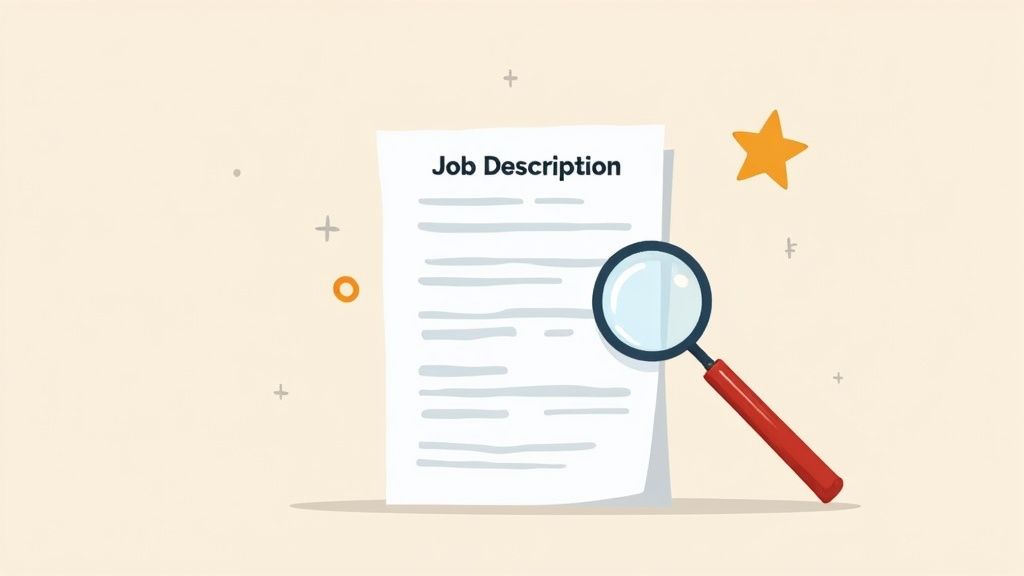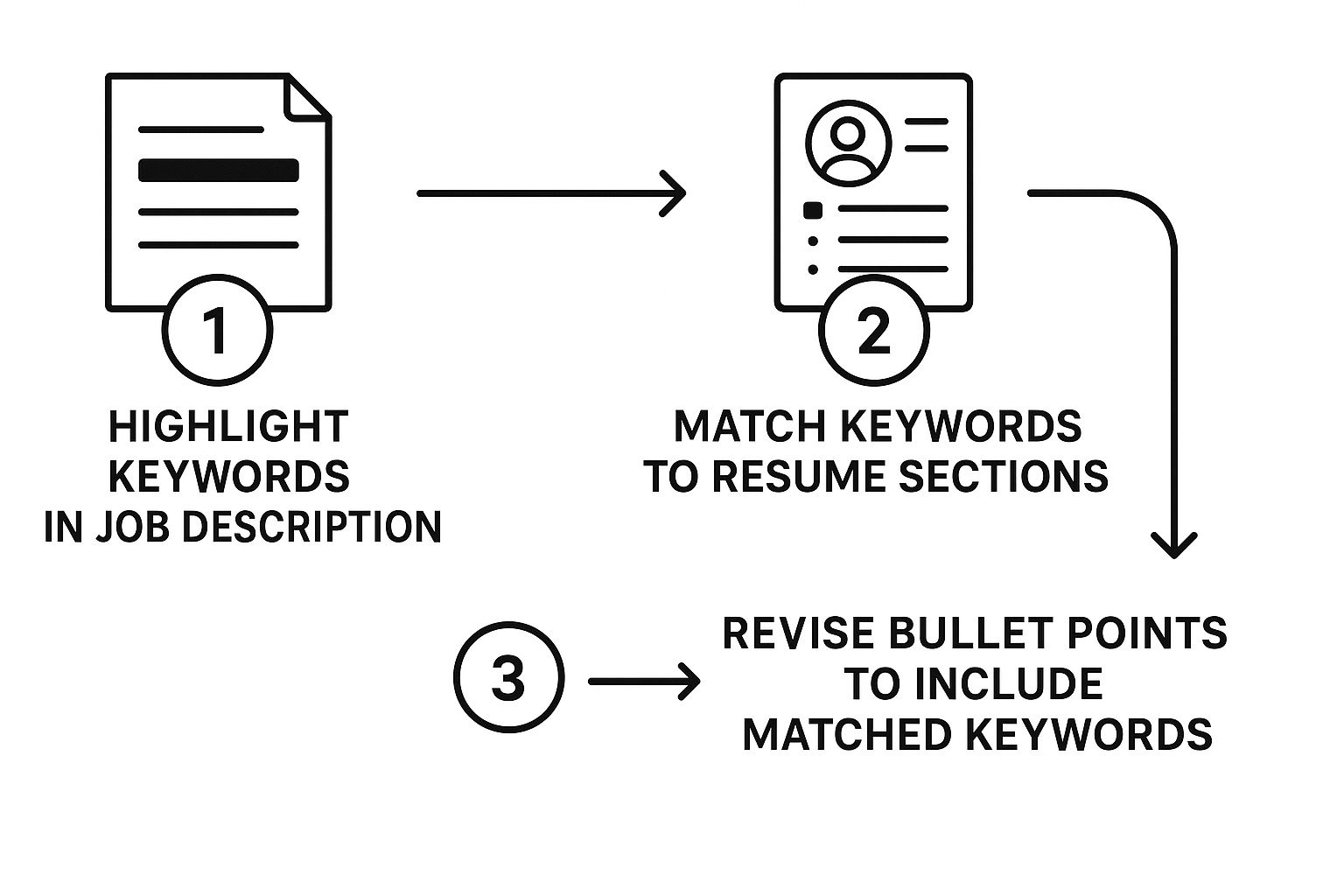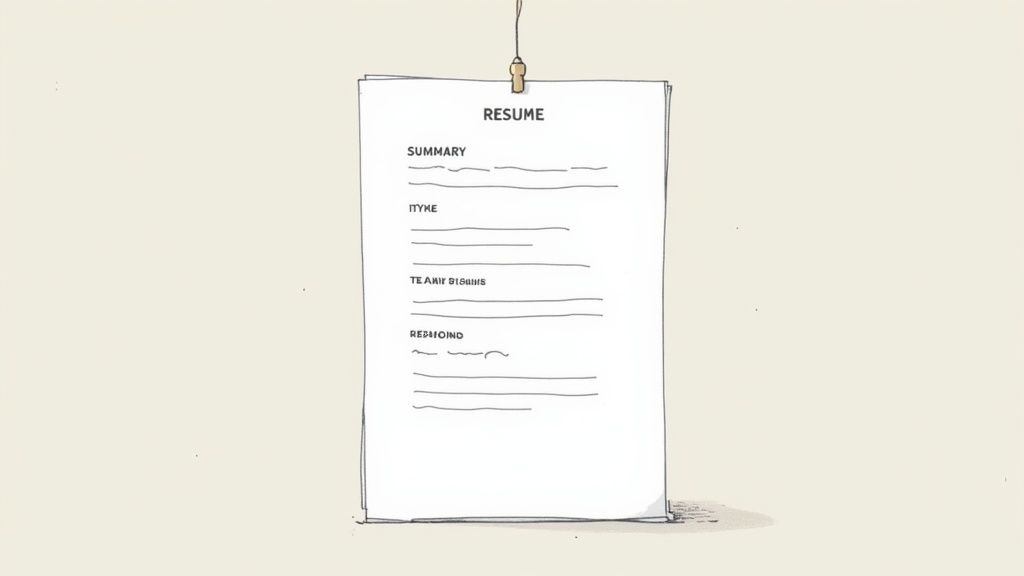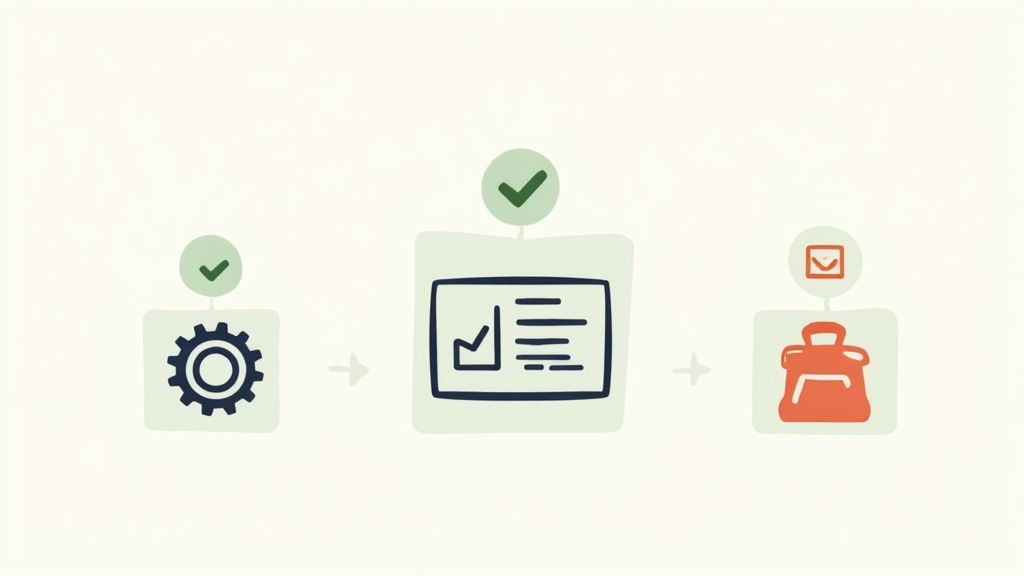
How to Tailor Resume to Job Description & Get Hired
When you tailor your resume, you’re doing more than just swapping out a few words. You’re dissecting the job description to find the exact skills and qualifications the employer wants, and then you’re meticulously weaving that language into your own resume.
This process shows the hiring manager you’re not just another applicant—you’re the solution to their problem. It’s about proving you are the perfect fit, not just a fit.
Why Your Generic Resume Isn’t Getting You Interviews
Sending out the same resume for every job application is a surefire way to get lost in the shuffle. Let’s be real: in a crowded job market, recruiters are looking for people who’ve put in the effort to connect their skills directly to the role they’re trying to fill. A generic, one-size-fits-all resume just does not communicate your value and fit for the company.

Put yourself in the recruiter’s shoes for a minute. They’re staring at a pile of hundreds of applications for one open position and spending just seconds on each one. A tailored resume jumps off the page because it uses the same terminology and highlights the exact qualifications they listed in the job post. It makes their job easier.
Clearing the Two Main Hurdles
Before a hiring manager ever sees your resume, it has to get past two major gatekeepers: the human recruiter and the automated software.
- The 6-Second Recruiter Scan: A real person is going to give your resume a quick glance, looking for an obvious match. If your summary and most recent experience don’t immediately echo the job’s top priorities, you’re likely headed for the “no” pile.
- The ATS Filter: Most companies rely on Applicant Tracking Systems (ATS) to do the initial screening. This software is designed to scan for specific keywords pulled directly from the job description. If those keywords are missing from your resume, you could be rejected before a human ever lays eyes on it.
The numbers don’t lie. One recent survey found that 61% of employers are more likely to give a second look to applicants who customize their resumes. This clearly shows that employers value candidates who can draw a direct line between their experience and the company’s needs. You can learn more about how tailoring impacts employer decisions.
Customization isn’t just about making small edits. It’s a strategic move to align your career narrative with what the employer desperately needs. It shows you’ve done your homework and are serious about the opportunity.
How to Read a Job Description Like a Recruiter
Before you even think about touching your resume, you need to put on your detective hat. The goal here isn’t just to skim for obvious keywords; it’s about dissecting the job posting to build a mental picture of the person they’re desperate to hire. Think of it as creating a blueprint for the perfect candidate.
I always tell people to either print the job description out or save it as a PDF they can mark up. There’s something about physically highlighting and making notes that forces you to slow down and really absorb what you’re reading. It’s a small step that makes a huge difference.
Differentiate Must-Haves from Nice-to-Haves
Let’s be real: not all requirements listed in a job description carry the same weight. Recruiters often throw in a mix of absolute deal-breakers and a “wish list.” Your first job is to figure out which is which.
- Must-Haves: These are your non-negotiables. Look for explicit language like “requires,” “minimum of 5 years,” or “must have.” These are often the hard skills, specific software proficiencies (like ‘expert in Salesforce’), or years of experience that an Applicant Tracking System (ATS) is programmed to screen for first. If you don’t have these, you’re likely to get filtered out automatically.
- Nice-to-Haves: Keep an eye out for softer phrases like “preferred,” “a plus,” or “familiarity with.” These are the bonus points. They can make you a stronger candidate, but they probably won’t be the reason you’re rejected.
Knowing the difference helps you dedicate your resume’s most valuable real estate—like the professional summary at the top—to the things that truly matter for that specific role.
This quick visual guide shows exactly how to pull those keywords from the job ad and strategically place them in your resume.

Following a process like this ensures your resume speaks the exact language the recruiter and the ATS are looking for.
Translating Job Description Keywords into Resume Skills
It’s not just about having the right skills; it’s about phrasing them correctly. Mirroring the language from the job description makes your qualifications immediately recognizable. Here’s how you can translate your abilities into their exact terminology.
| Generic Skill | Job Description Keyword | Tailored Resume Skill |
|---|---|---|
| Project Management | ”Manage cross-functional projects” | Managed 5 cross-functional projects simultaneously from conception to launch. |
| Data Analysis | ”Analyze performance data” | Analyzed performance data using SQL and Tableau to identify key market trends. |
| Customer Service | ”Develop client relationships” | Developed lasting client relationships, increasing retention by 15%. |
See the difference? The tailored version is specific, uses the company’s language, and includes a measurable result. That’s the combination that gets you noticed.
Uncover the Core Responsibilities and Company Culture
Beyond the skills checklist, pay close attention to the verbs. What will you actually be doing all day? If the description keeps mentioning “spearhead new marketing campaigns” or “streamline operational workflows,” those are the core functions of the job. You need to show you’ve done exactly that.
A job description is more than a list of qualifications—it’s a story about the company’s current problems. The skills they’re asking for are the solutions they need. Your resume’s job is to frame you as the hero of that story.
Finally, listen to the language they use to describe themselves. Are they “fast-paced,” “highly collaborative,” or looking for an “independent self-starter”? These words are massive clues about the work environment. Weaving these cultural keywords into your summary or cover letter shows you didn’t just apply—you paid attention. It tells them you’re not just qualified on paper; you’re the right fit for the team.
Getting Your Resume Past the ATS Robots
Let’s be real: before a hiring manager ever sees your resume, it has to get past the robots first. These digital gatekeepers, known as Applicant Tracking Systems (ATS), are the first hurdle in the modern job hunt. They aren’t looking for creativity; they’re scanning for keywords and proper formatting, and if you don’t play by their rules, your application gets tossed into the digital void.

The primary job of an ATS is to parse your resume for specific skills, qualifications, and experiences that line up with the job description. And they are everywhere—over 98% of Fortune 500 companies rely on them. This means your resume’s ability to clear this initial screening is everything. If it doesn’t have enough of the right keywords, it’s often an automatic rejection. You can get more insights into how ATS technology shapes the hiring process on remote.com.
This is why matching the exact phrasing from the job post is so critical. If they’re looking for “project management” experience, simply writing “managed projects” might not cut it for a less sophisticated ATS. It’s a game of matching, plain and simple.
Formatting for the Machines
Even a resume packed with perfect keywords can get rejected if the ATS can’t read it. These systems are powerful, but they’re not smart. Complex designs, fancy fonts, and creative layouts can completely trip them up.
I once worked with a talented graphic designer whose stunning, visually rich resume kept getting ignored. The issue wasn’t a lack of skill; it was the two-column layout and embedded graphics. To the ATS, it was just a garbled mess of text, not a decade of incredible work.
To make sure your resume is readable, stick to these guidelines:
- File Type: Always submit a .docx file unless the application explicitly asks for a PDF. Some older ATS platforms still struggle to correctly parse information from PDFs.
- Layout: Keep it simple. A single-column, top-to-bottom flow is your safest bet. Avoid using columns, tables, or text boxes, as these can scramble your content.
- Fonts: Stick with the classics. Standard, web-safe fonts like Arial, Calibri, or Times New Roman work best. That custom script font might look great, but the ATS won’t be able to read it.
- Headers & Footers: Don’t put essential information like your name or contact details in the header or footer. Some systems are programmed to skip these sections entirely.
Your first audience isn’t human. By optimizing for the ATS first, you’re making sure a person actually gets a chance to see your qualifications. Think clean, simple, and keyword-rich. It’s not about being boring—it’s about being strategic.
Rewriting Your Resume for Maximum Impact
Alright, you’ve got your list of keywords and a solid understanding of what the hiring manager is looking for. Now it’s time for the fun part: a little resume surgery.
We’re not talking about a complete gut job. Instead, think of this as a strategic renovation. The goal is to shift your resume from a simple record of your past duties into a powerful argument for why you’re the perfect fit for this specific role.
The most important real estate on your resume is the top third of the first page. It’s your one shot to hook the reader and convince them you’re worth a closer look.
Craft a Job-Winning Professional Summary
Let’s get one thing straight: the old-school “Objective” statement is dead. In its place is the Professional Summary, and it’s your secret weapon. This is your 3-4 sentence elevator pitch, and it needs to hit the job’s biggest “must-haves” right away. I like to think of it as the grand finale of your cover letter, but placed right at the top where no one can miss it.
Let’s say a company is looking for a digital marketing manager with a knack for SEO and content strategy.
- Before: “Results-driven marketing professional with 8 years of experience in leading successful campaigns.” (This is okay, but it’s generic.)
- After: “Strategic Digital Marketing Manager with 8 years of experience driving traffic and engagement through expert SEO and data-driven content strategy. Proven ability to increase organic search rankings by over 200% for SaaS companies.”
See the difference? The second version pops. It uses their language, includes a hard number, and immediately tells the hiring manager, “I have exactly what you’re looking for.”
A great professional summary answers the recruiter’s silent question: “Why should I keep reading?” It connects your top qualifications directly to their biggest needs from the very first line.
Transform Your Work Experience with a Twist
If your summary is the headline, your Work Experience section is the evidence. This is where you prove you can walk the walk. Most people have heard of the STAR method (Situation, Task, Action, Result), and it’s a great starting point. But the real trick is to tailor the Result part of your bullet point to align with the company’s goals.
Every bullet point is a chance to tell a mini-story about your impact. As you rewrite them, keep asking yourself: how does this accomplishment solve a problem this company is likely facing? Frame your past wins in the context of their future needs.
For example, imagine a job description that repeatedly mentions “improving operational efficiency.”
- Generic Bullet: “Responsible for managing inventory systems.” (This just says what you did.)
- Tailored Bullet: “Implemented a new inventory management system that reduced order processing time by 25% and cut waste by 15%, directly improving operational efficiency.” (This shows the result they care about.)
When you take this approach, every bullet point becomes another piece of evidence that you’re the right person for the job. Your resume stops being a list of tasks and transforms into a persuasive document that screams, “Hire me.” This is how you tailor your resume to a job description and actually get results.
Use AI to Tailor Your Resume in Half the Time
Let’s be real: customizing your resume for every single job is a grind. It’s one of those tedious but absolutely essential steps that can make you want to throw in the towel after just a few applications. This is exactly where AI tools can be a game-changer, acting like a savvy co-pilot to speed things up without sacrificing quality.

These platforms do more than just hunt for keywords. A good AI tool will dissect a job description, pinpoint the most crucial skills, and then give you concrete suggestions for rephrasing your experience to align perfectly.
For example, instead of a generic “project management skills” line, it might suggest a more powerful bullet point like, “Spearheaded five cross-functional projects, delivering them 15% ahead of schedule.” That’s the kind of specific, impactful language that gets a hiring manager’s attention.
Making AI Work for You (Not the Other Way Around)
The trick is to treat these tools as a collaborator, not a crutch. They are brilliant for getting a first draft done and making sure you’ve hit all the right ATS keywords, but the final, human touch has to come from you.
Here’s how to do it right:
- Start with a strong foundation. You need a solid, detailed master resume. The better the raw material you give the AI, the more targeted and useful its suggestions will be.
- Always review and refine. Never just copy and paste. Does the AI’s phrasing sound like you? Does it accurately represent what you did? You’re the final editor.
- Cross-check the keywords. Do a quick scan yourself to make sure the tool didn’t miss any of the big, must-have qualifications from the job post.
Think of AI as your personal efficiency expert. It automates the grunt work of keyword matching, which frees you up to focus on what really matters: telling your career story and quantifying your achievements.
Modern AI can now customize your resume in real time. Tools that run on natural language processing can dynamically rework your resume, pulling forward the skills and accomplishments that speak directly to what a specific employer is looking for. You can see more on how platforms are streamlining resume tailoring on huntr.co.
Your Resume Customization Questions, Answered
Alright, let’s get into the nitty-gritty. When you start tailoring your resume for every single job, a few practical questions always seem to pop up. Here are the answers to the ones I hear most often.
How Much of My Resume Do I Really Need to Tweak?
Good news: you don’t have to start from scratch every time. That would be exhausting. The key is to be strategic and focus on the parts of your resume that make the biggest first impression.
I always recommend focusing your energy on these three high-impact areas:
- Your Professional Summary: This is your elevator pitch. Rework these 3-4 sentences to directly reflect the top 2-3 requirements you see in the job description.
- Recent Work Experience: You don’t need to change everything. Just look at your most recent roles and tweak 2-3 bullet points under each one. Weave in specific keywords and metrics from the job post to show you’ve done this kind of work before.
- The Skills Section: This one’s easy. Make sure the skills listed here mirror the language used in the posting. If they ask for “Salesforce,” make sure your resume says “Salesforce,” not “CRM Platforms.”
This targeted approach gives you the most bang for your buck, making your resume feel custom-built for the role without eating up your entire day.
Is a Cover Letter Still Worth the Effort?
Yes. A thousand times, yes. It’s true that some hiring managers might skim or even skip it, but for the ones who do read it, a great cover letter can be the tiebreaker.
Your resume is a factual list of what you’ve done. Your cover letter is where you connect those facts to the company’s specific needs and show a little personality. It’s your chance to explain why you’re so excited about this particular role and this specific company. This is especially vital if you’re switching careers or have a less-than-traditional career path.
Think of it this way: Your resume shows them what you can do. Your cover letter tells them why you want to do it for them.
When you’ve put in the work to tailor both, you can finally hit that ‘submit’ button with confidence, knowing you’ve given it your best shot.
Tired of spending hours manually tweaking your resume? Jobcamp uses AI to instantly create a perfectly tailored resume and cover letter for any job you want. It’s a game-changer for getting more responses and landing interviews faster. You can get started for free on Jobcamp’s website.

